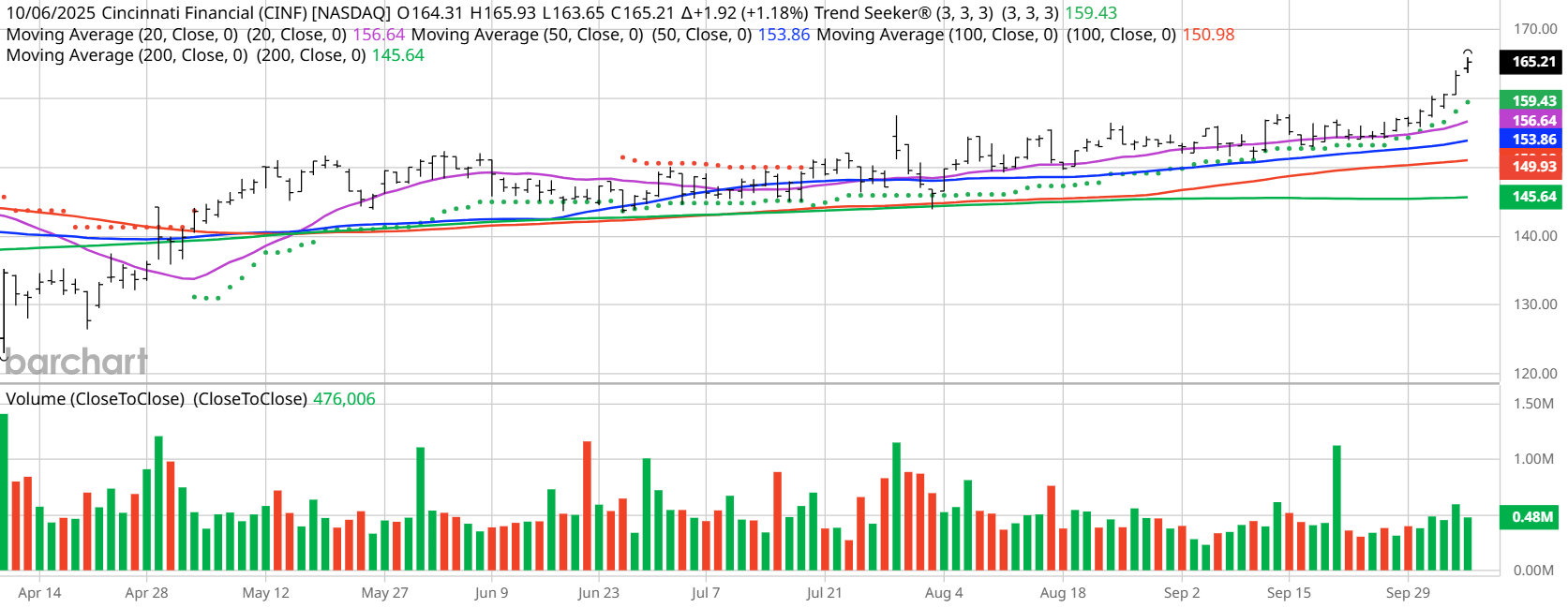
- Cincinnati Financial (CINF) is showing strong technical momentum and is trading at new all-time highs.
- CINF has a 100% “Buy” technical opinion from Barchart.
- Shares are up 25% over the past year.
- While CINF offers growth and income potential, investors should be mindful of volatility and use disciplined risk management strategies.
Today’s Featured Stock
Valued at $25.8 billion, Cincinnati Financial (CINF) markets property and casualty insurance and has an investment portfolio. The company owns three subsidiaries: The Cincinnati Insurance Company, CSU Producer Resources Inc., and CFC Investment Company.
What I’m Watching
I found today’s Chart of the Day by using Barchart’s powerful screening functions to sort for stocks with the highest technical buy signals; superior current momentum in both strength and direction; and a Trend Seeker “buy” signal. I then used Barchart’s Flipcharts feature to review the charts for consistent price appreciation. CINF checks those boxes. Since the Trend Seeker signaled a new “Buy” on July 18, the stock has gained 10.2%.
CINF Price vs. Daily Moving Averages:

Barchart Technical Indicators for Cincinnati Financial
Editor’s Note: The technical indicators below are updated live during the session every 20 minutes and can therefore change each day as the market fluctuates. The indicator numbers shown below therefore may not match what you see live on the Barchart.com website when you read this report. These technical indicators form the Barchart Opinion on a particular stock.
CINF hit an all-time high of $166.61 in morning trading on Oct. 7.
- CINF has a Weighted Alpha of +25.47.
- It has an 100% “Buy” opinion from Barchart.
- The stock gained 25.27% over the past year.
- CINF has its Trend Seeker “Buy” signal intact.
- It is trading above its 20-, 50-, and 100-day moving averages.
- The stock has made 10 new highs and gained 8.52% in the last month.
- Relative Strength Index (RSI) is at 76.23.
- There’s a technical support level around $163.93.
Don’t Forget the Fundamentals
- $25.8 billion market capitalization.
- 25.96x trailing price-earnings ratio.
- 2.11% dividend yield.
- Revenue is projected to grow 2.42% this year and another 6.21% next year.
- Earnings are estimated to increase 35.83% next year.
Analyst and Investor Sentiment on CINF
I don’t buy stocks because everyone else is buying, but I do realize that if major firms and investors are dumping stock, it’s hard to make money swimming against the tide.
It looks like Wall Street analysts have positive but mixed opinions on CINF.
- The Wall Street analysts tracked by Barchart have issued 3 “Strong Buy,” 1 “Moderate Buy” and 6 “Hold” opinions on the stock with price targets between $145 and $175.
- Value Line gives the stock its “Above Average” rating with a price target of $175 and comments: “Cincinnati Financial has posted excellent top-line results. Premiums earned have increased, thanks to price hikes, premium growth initiatives, and a higher level of insured exposures.”
- CFRA’s MarketScope Advisor rates it a “Hold” with a price target of $170.
- Morningstar thinks the stock is 9% overvalued.
- 761 investors following the stock on Motley Fool think the stock will beat the market while 93 think it won’t.
- 18,370 investors monitor the stock on Seeking Alpha, which rates the stock a “Hold” and comments: “Cincinnati Financial’s solid dividend history and strategic focus on maintaining profitability through underwriting expertise have allowed it to outperform industry averages.”
The Bottom Line on Cincinnati Financial
Analysts project growth in revenue and earnings for Cincinnati Financial, and the company has a solid dividend history. Investors should note the stock’s volatility and employ disciplined risk management.
Today’s Chart of the Day was written by Jim Van Meerten. Read previous editions of the daily newsletter here.
Additional disclosure: The Barchart of the Day highlights stocks that are experiencing exceptional current price appreciation. They are not intended to be buy recommendations as these stocks are extremely volatile and speculative. Should you decide to add one of these stocks to your investment portfolio it is highly suggested you follow a predetermined diversification and moving stop loss discipline that is consistent with your personal investment risk tolerance.







